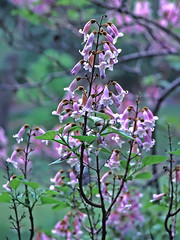Ecological Threats
Each natural community faces ecological threats that could change its defining features, leading to its decline.
Learn More
Other Websites
Non-Native Invasive Plants
The Tuliptree Small-Stream Floodplain Forest is particularly vulnerable to non-native invasive plants. Its nutrient-rich floodplain terrace sediments and sun-soaked sand/gravel bars are good "real estate," and frequent disturbance by flooding clears space for seeds and plant parts washed in from residential areas and woods upstream. The harms caused by non-native invasive plants include competition with natives for soil nutrients, sunlight, and pollinators, and degradation of animal habitat.
Though any number of non-native invasive plants may take root here, only flood-tolerant plant species survive long. Among the most aggressive are the yellow-blooming lesser celandine (which forms a carpet along many of Rock Creek Park's floodplains), Japanese stiltgrass, Japanese knotweed, and Japanese honeysuckle. Ecobit: Lesser Celandine in Rock Creek Park (* indicates non-native)
 The purple blooms of the non-native invasive princess tree produce thousands of seeds each year.
The purple blooms of the non-native invasive princess tree produce thousands of seeds each year.
Photographer: Gary Flemingbeefsteak plant* (low plant)- bush honeysuckle* (shrub)
- Chinese wisteria* (vine)
- common barberry* (shrub)
- common periwinkle* (vine)
- English ivy* (vine)
- garlic mustard* (low plant)
- ground-ivy* (low plant)
- Indian-strawberry* (low plant)
- Japanese barberry* (shrub)
- Japanese honeysuckle* (vine)
- Japanese hop* (shrub)
- Japanese knotweed* (low plant)
- Japanese maple* (tree)
 The highly invasive non-native shrub linden arrow-wood is a problem at Rock Creek Park.
The highly invasive non-native shrub linden arrow-wood is a problem at Rock Creek Park.
Photographer: Gary FlemingJapanese snowball* (shrub)- Japanese snowbell* (shrub)
- Japanese stiltgrass* (low plant)
- lesser celandine* (low plant)
- linden arrow-wood* (shrub)
- mile-a-minute weed* (vine)
- multiflora rose* (shrub)
- Norway maple* (tree)
- oriental bittersweet* (vine)
- porcelain-berry* (vine)
- princess-tree* (tree)
- privets* (shrub)
- silktree* (tree)
- tree-of-heaven* (tree)
- wine raspberry (shrub)
- winged burning-bush (shrub)
- winter-flowering cherry* (tree)
Diseases, Pests, and Other Threats
Current and potential ecological threats for the Tuliptree Small-Stream Floodplain Forest in Rock Creek Park include the following:
- Flash flooding: erosion from high volume, velocity, and duration of floodwaters; polluted urban and agricultural stormwater runoff
- Manmade obstructions on floodplains: increased height/breadth of floods; degradation of habitat
- Manmade obstructions or channelization in streams: degradation of habitat for migrating fish, aquatic creatures
- Long-term drought: growth of flood-intolerant trees and shrubs that will not survive future flood cycles
- Excessive deer browse: decimation of wildflowers, some tree seedlings and shrubs (but not pungent northern spicebush or pawpaw)
- Emerald ash borer (potential): damage to green ash
- Viburnum leaf beetle (potential): damage to blackhaw and southern arrow-wood
- Asian long-horned beetle (potential): damage to maples, box-elder, elms, river birch, American sycamore, and willow
- Dutch elm disease: damage to American elm and slippery elm
- Elm yellows (potential): damage to American elm and slippery elm



